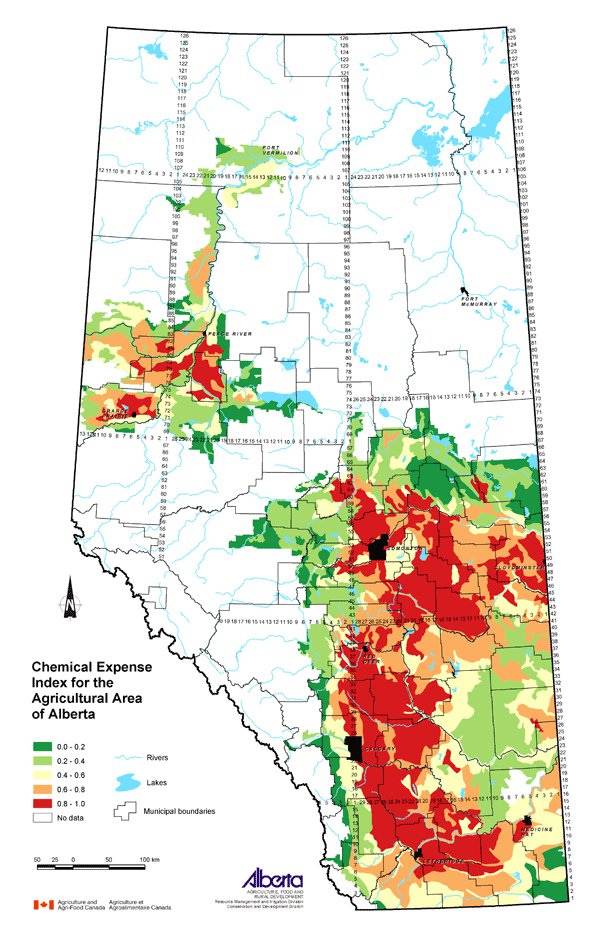| | Description | Data sources | Potential uses | Limitations | Further information | Download spatial information
Description
This map describes the relative expense of farm chemicals (herbicides, insecticides and fungicides) in the agricultural area of Alberta. It is an estimate of the degree to which crop production agriculture may contribute to surface or groundwater contamination. The classes shown on the map are ranked between 0 (lowest) and 1 (highest).
Data Sources
Data on the amount spent on chemicals (herbicides, insecticides and fungicides totalled together) by producers was collected during the 2001 Census of Agriculture. Custom processing of the Census data by Statistics Canada gives the chemical expense ($) for each Soil Landscapes of Canada (SLC) polygon. That amount was divided by the SLC area (square km) to result in a ratio of the amount spent on farm chemicals per unit area for each SLC.
SLC Version 1.9 was used for this map. SLC polygons were created using existing soil survey information. Each polygon is described by a standard set of soil and land attributes that characterizes the soil landscapes found in each SLC polygon. Soils, landscapes and climate are the key natural resource factors that determine agricultural productivity, and the farms within a soil landscape unit usually have similar production characteristics.
The values for each SLC were ranked with the lowest value assigned a new value of 0.0 and the SLC with the maximum ratio assigned a new value of 1.0. All other values were assigned a new value between 0.0 and 1.0 based on their rank order.
Potential Uses
Agricultural production that makes greater use of herbicides, insecticides and pesticides is generally considered more intensive. Presenting the relative farm chemical expenses by SLC polygon reveals where the most intensive agricultural production in the province occurs.
Farm chemical use has been used as one component of an Agricultural Intensity Index (AII), developed through the Alberta Environmentally Sustainable Agriculture (AESA) Water Quality Monitoring Program. Work by Anderson, Cooke and MacAlpine (1999) and by Johnson and Kirtz (1998) developed that Index. The AII has been identified as a good indicator of agricultural impacts on surface water.
Chemical use is therefore a part of that equation to determine a measure of surface water quality risk. If an area is known to have certain risk factors that would affect not only surface, but groundwater quality as well, a higher chemical expense index ranking in that same area may be of concern. Where risks of surface or groundwater contamination exist, environmental farm planning can help to minimize them.
Limitations
Chemical expense data from the 2001 Census of Agriculture is used here as a proxy for the actual amount of herbicides, insecticides and fungicides that are applied. No adjustment has been made for differences in farm chemical prices across the province.
Further Information
The AESA Water Quality Monitoring Program directs the numerous water quality monitoring activities taking place across the province. From the Alberta Agriculture and Food (AF) website, use the topic bar on the left and follow: Soil/Water/Air, Water Quality and Stream Monitoring. www.agric.gov.ab.ca
2001 Census of Agriculture website expands on the use of the data collected. www.statcan.ca/english/agcensus2001
Canadian Soil Information System (CanSIS) provides soils information and data including information about SLCs. From the CanSIS website under Data, click on Soil Landscapes on the left side topic bar. http://sis.agr.gc.ca/cansis
Anderson, A., Cooke, S. and MacAlpine, N. 1999. Watershed Selection for the AESA Stream Water Quality Monitoring Program. Alberta Environmentally Sustainable Agriculture, AF.
Johnson, I. and Kirtz, J. 1998. Agricultural Intensity in Alberta, 1996 and Changes Since 1991. Alberta Environmentally Sustainable Agriculture, AF.
Click on map for larger view

Download Spatial Information
Agricultural Land Resource Atlas of Alberta - Chemical Expense Index for the Agricultural Area of Alberta
|
|